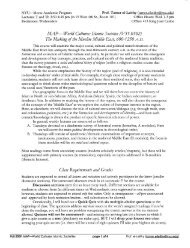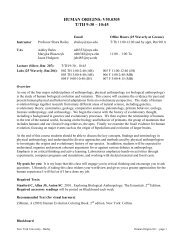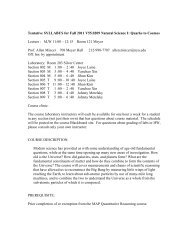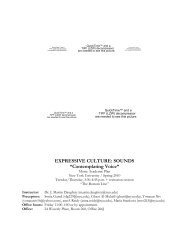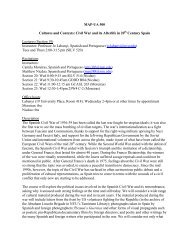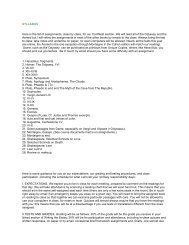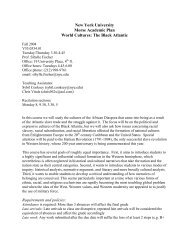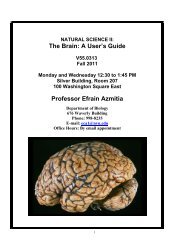syllabus
syllabus
syllabus
You also want an ePaper? Increase the reach of your titles
YUMPU automatically turns print PDFs into web optimized ePapers that Google loves.
I. Introduction<br />
Natural Science I: Energy and the Environment<br />
V55.0203 – Fall 2004<br />
Prof. Henry C. Brenner<br />
Department of Chemistry<br />
Main 1001N<br />
998-8432<br />
henry.brenner@nyu.edu<br />
Office Hour: Monday, 4 –5<br />
This course explores the scientific foundations of current environmental issues and their challenges for<br />
public policy. One goal of the course is to address directly many topics of crucial importance and current<br />
lively debate in our technology-based society, such as global warming, the quest for clean air and water,<br />
atmospheric ozone depletion, and the continuing search for viable sources of energy. A parallel aim is to<br />
impart a basic understanding of key chemical and physical concepts such as the structure of atoms and<br />
molecules, the interaction of light with matter, energy relationships in chemical reactions, and the<br />
properties of acids and bases. As you will see, these concepts are introduced within the context of the<br />
discussion of the relevant environmental problems and will help you gain a fuller understanding of these<br />
problems. At the end of the course we hope that you will have gained an appreciation and hopefully an<br />
interest in the role of chemistry in our world, and that you will have acquired an intelligent and informed<br />
perspective with regard to environmental and energy-related issues.<br />
II. Textbooks<br />
There are two required texts for this course. The lecture text is Chemistry in Context: Applying<br />
Chemistry to Society (4th Edition), by Stanitski, Eubanks, Middlecamp and Pienta (American Chemical<br />
Society, McGraw-Hill, 2003). Make sure you have the 4th edition, as it has been substantially revised<br />
from previous editions. There is also a Laboratory Manual. Both texts are available in the NYU<br />
Bookstore.<br />
III. Lectures and Laboratories<br />
The lectures are Tuesday and Thursday, 11:00 AM – 12:15 PM, in Room 207, Silver Center. A<br />
tentative lecture schedule appears later in this <strong>syllabus</strong>. All students in this course are required to register<br />
for one of the laboratory sections, which meet on Friday and Monday. You cannot receive credit for this<br />
course without taking the laboratory. Laboratories are held in room 455 Brown, and will begin on Friday,<br />
Sept. 17 (No labs Friday, Sept. 10 or Monday, Sept. 13).<br />
IV. Communication<br />
An NYU Blackboard page, which can be accessed through your home.nyu.edu page (click on<br />
"Academics"), will be set up shortly after the beginning of the semester. Check this page frequently for<br />
announcements and other course materials. You will receive information via your NYU e-mail address<br />
once it has been set up.
V. Attendance<br />
Attendance will not be taken in lecture, but it is of course to your benefit to attend and find out what is<br />
going on in the course. Attendance is required in laboratory. There are no make-ups for the laboratory<br />
experiments or laboratory quizzes. If you miss a lab period because of illness you must present a doctor’s<br />
note to your lab instructor explaining your absence. If you do not, you will receive a grade of zero for the<br />
laboratory work on that day. If you intend to miss a lab because of a religious holiday, you should inform<br />
your instructor in advance. In the case of excused absences, your grade for the laboratory will be based<br />
on the remaining laboratories that you did perform. However, if you miss four or more lab assignments<br />
for whatever reason, you will receive a grade of zero for the laboratory part of this course.<br />
VI. Homework<br />
Approximately ten homework problems will be assigned in lecture each week. They are to be handed<br />
in at the beginning of your laboratory period the following week. An unannounced selection of problems<br />
from the homework will be graded. Each homework assignment will be worth 10 points. Late<br />
assignments must be placed in the mailbox outside of Room 202 Main. Late homework will be<br />
downgraded 3 points per day late. A list of homework problems is given at the end of this <strong>syllabus</strong>.<br />
Please note that even if you miss a laboratory session due to a documented absence (see V, above) you are<br />
still required to complete the homework assignment. Contact your laboratory instructor to arrange a<br />
suitable deadline for submitting the work.<br />
VII. Teaching Assistants<br />
The teaching assistants for this course are: Azaria Eisenberg (ase217@nyu.edu), Aiming Gao<br />
(ag746@nyu.edu) and Nahum Shiffeldrim (ns706@nyu.edu) and They are all experienced graduate<br />
students in the Department of Chemistry. They will lead you through your laboratory sessions and will<br />
also give occasional problem sessions (to be announced) and review sessions for the midterm and final<br />
examinations.<br />
VIII. Basis of the Final Grade<br />
The course will be graded on the basis of a single midterm (see schedule), a final, homework, lab<br />
quizzes, and laboratory work. The quizzes are given during the first ten minutes of the laboratory period,<br />
so be on time. The quizzes will be based on the procedure and basic theory for the laboratory assignment<br />
for that day, and are given to ensure that you read the assignment ahead of time and know what is to be<br />
done in lab on that day. The midterm and final examinations will be based on text, lecture and laboratory<br />
material. The percentage breakdown is as follows:<br />
Midterm Examination 30%<br />
Final Examination 30%<br />
Homework 10%<br />
Laboratory Work 30%<br />
Each laboratory exercise is worth 50 points and the breakdown is as follows:<br />
Attendance 10 points<br />
Quiz 10 points<br />
Lab Assignment 30 points
V55.0203: Natural Science I: Energy and the Environment<br />
Fall 2004<br />
Lecture and Laboratory Schedule<br />
Date Chapter Title Laboratory Assignments<br />
Sept. 7 Introduction<br />
Sept. 9 1 The Air We Breathe<br />
Sept. 10/13 No Lab<br />
Sept. 14 1<br />
Sept. 16 1<br />
Sept. 17/20 Lab 1: Properties of Air<br />
Sept. 21 2 Protecting the Ozone Layer<br />
Sept. 23 2<br />
Sept. 24/27 Lab 2: Properties of Light<br />
Sept. 28 2<br />
Sept. 30 3 The Chemistry of Global Warming<br />
Oct.1/4 Lab 3: Spectroscopy<br />
Oct. 5 3<br />
Oct. 7 3<br />
Oct. 8/11 Lab 4: Molecular Models<br />
Oct. 12 3<br />
Oct. 14 4 Energy, Chemistry and Society<br />
Oct. 15/18 Lab 5: Heat of Reaction<br />
Oct. 19 4<br />
Oct. 21 4<br />
Oct. 22/25 Review for Midterm<br />
Oct. 26 5 The Water We Drink<br />
Oct. 28 Midterm Examination<br />
Oct. 29/ Nov. 1 Lab 6: Aqueous Ion Reactions<br />
Nov. 2 5 The Water We Drink (cont.)<br />
Nov. 4 5<br />
Nov. 5/8 Lab 7: Water Hardness<br />
Nov. 9 6 Neutralizing the Threat of Acid Rain<br />
Nov. 11 6<br />
Nov. 12/15 Lab 8: Acid Rain<br />
Nov. 16 6
Lecture and Laboratory Schedule (continued)<br />
Nov. 18 8 Energy from Electron Transfer<br />
Nov. 19/22 Lab 9: Building Batteries<br />
Nov. 23 8<br />
Nov. 30 8<br />
Dec. 2 7 The Fires of Nuclear Fission<br />
Dec. 3/6 Lab 10: Photovoltaics<br />
Dec. 7 7<br />
Dec. 9 7<br />
Dec. 10/13 Review for Final Exam<br />
Dec. 14 Review<br />
Dec. 21 Final Examination (10:00 – 11:50)<br />
A list of representative homework problems is given below. The weekly assignments will most likely be<br />
drawn from this list, although supplementary problems may also be included.<br />
Chapter Homework<br />
1 1, 4, 5, 7, 9, 14-19, 21, 36, 37<br />
2 2, 3, 7, 8, 10-15, 18, 20, 28, 30, 37, 44<br />
3 1, 2, 4, 6, 9-15, 18, 20, 21, 22, 25, 28, 32<br />
4 2, 3, 4, 6, 9, 12, 14, 18, 19, 22, 24, 29, 42, 43, 47<br />
5 2, 4, 5, 8, 9, 11, 12, 13, 15, 17, 18-24, 31<br />
6 1, 3, 6, 7, 8, 9, 14, 15, 16, 19, 21, 30, 31, 36, 40, 43<br />
8 1-3, 6, 7, 12, 22-25, 33-36<br />
7 4, 9, 10, 12, 14, 22, 23, 24, 26, 31, 32<br />
All problems are from the text: Chemistry in Context: Applying Chemistry to Society, 4th Edition, by<br />
Stanitski, Eubanks, Middlecamp, and Pienta (American Chemical Society, McGraw-Hill, 2003)



